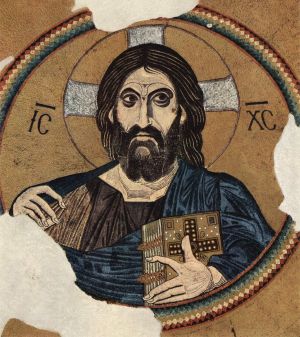Difference between revisions of "Christogram" - New World Encyclopedia
Scott Dunbar (talk | contribs) (Imported and credited a 2nd article) |
Scott Dunbar (talk | contribs) m |
||
| Line 23: | Line 23: | ||
==Chrismon== | ==Chrismon== | ||
| − | |||
[[Image:Chirho.svg|thumb|right|The labarum: the definitive Chi-Rho chrismon]] A '''chrismon''' is one of number of [[Christian]] [[symbol]]s intended to represent aspects of the Person, life or ministry of [[Jesus Christ]] and the life, ministry or history of the [[Christian Church]] through a single image, emblem or monogram. The term "chrismon" comes from the Latin phrase "Christi Monogramma", meaning "monogram of Christ". By definition, the literal monogram of Christ is the more commonly named [[labarum]] or "Chi Rho", which is the [[Greek letters]] Χ ("chi") superimposed upon Ρ ("rho"). Often, the Ρ is formed to look like a shepherd's crook and the Χ like a cross, symbolizing Jesus Christ as [[The Good Shepherd (Christianity)|Good Shepherd]] of his flock, the Christian Church. | [[Image:Chirho.svg|thumb|right|The labarum: the definitive Chi-Rho chrismon]] A '''chrismon''' is one of number of [[Christian]] [[symbol]]s intended to represent aspects of the Person, life or ministry of [[Jesus Christ]] and the life, ministry or history of the [[Christian Church]] through a single image, emblem or monogram. The term "chrismon" comes from the Latin phrase "Christi Monogramma", meaning "monogram of Christ". By definition, the literal monogram of Christ is the more commonly named [[labarum]] or "Chi Rho", which is the [[Greek letters]] Χ ("chi") superimposed upon Ρ ("rho"). Often, the Ρ is formed to look like a shepherd's crook and the Χ like a cross, symbolizing Jesus Christ as [[The Good Shepherd (Christianity)|Good Shepherd]] of his flock, the Christian Church. | ||
Revision as of 06:26, 8 August 2008
A Christogram is a monogram or combination of letters which forms an abbreviation for the name of Jesus Christ, and is traditionally used as a Christian symbol. Different types of Christograms are associated with the various traditions of Christianity.
File:IHS-monogram-Jesus-medievalesque.svg
Eastern Orthodoxy

In Eastern Orthodoxy, the most widely used Christogram is a four-letter abbreviation ICXC — a traditional abbreviation of the Greek words for "Jesus Christ" (i.e., the first and last letters of each of the words ΙΗΣΟΥΣ ΧΡΙΣΤΟΣ — written "IHCOYC XPICTOC" with a transliteration of the lunate sigma common in medieval Greek as "C"). On icons this christogram may be split: "IC" on the left of the image and "XC" on the right, most often with a bar above the letters (see titlos), indicating that it was a sacred name. It is sometimes rendered as "ICXC NIKA", meaning "Jesus Christ Conquers."
"ICXC" may also be seen inscribed on the Ichthys. In the traditional Orthodox icon of Christ Pantokrator, Christ's right hand is shown in a pose that represents the letters IC, X and C.
Western Christianity
In the Latin-speaking Christianity of medieval Western Europe (and so among Catholics and many Protestants today), the most common Christogram is "IHS" or "IHC", derived from the first three letters of the Greek name of Jesus, iota-eta-sigma or ΙΗΣ. Here the Greek letter eta was transliterated as the letter H in the Latin-speaking West (Greek eta and Latin-alphabet H had the same visual appearance and shared a common historical origin), while the Greek letter sigma was either transliterated as the Latin letter C (due to the visually-similar form of the lunate sigma), or as Latin S (since these letters of the two alphabets wrote the same sound). Because the Latin-alphabet letters I and J were not systematically distinguished until the 17th century, "JHS" and "JHC" are equivalent to "IHS" and "IHC".
"IHS" is sometimes interpreted as meaning Iesus Hominum Salvator ("Jesus, Savior of men", in Latin), or connected with In Hoc Signo. Some uses have even been created for the English language, where "IHS" is interpreted as an abbreviation of "I Have Suffered" or "In His Service". Such interpretations are known as backronyms. Its use in the West originated with St. Bernardine of Siena, a 13th Century priest who popularized the use of the three letters on the background of a blazing sun to displace both popular pagan symbols and seals of political factions like the Guelphs and Ghibellines in public spaces.
One of the oldest Christograms is the Chi-Rho or Labarum. It consists of the superimposed Greek letters Chi Χ; and Rho Ρ, which are the first two letters of christ in Greek. Technically, the word labarum is Latin for a standard with a little flag hanging on it, used in the army. A Christogram was added to the flag as an image of the Greek letters Chi Rho, in the late Roman period. So Christogram and labarum are not originally synonyms.
The most commonly encountered Christogram in English-speaking countries in modern times is the X (or more accurately, Greek letter Chi) in the abbreviation Xmas (for "Christmas"), which represents the first letter of the word Christ.
Chrismon
A chrismon is one of number of Christian symbols intended to represent aspects of the Person, life or ministry of Jesus Christ and the life, ministry or history of the Christian Church through a single image, emblem or monogram. The term "chrismon" comes from the Latin phrase "Christi Monogramma", meaning "monogram of Christ". By definition, the literal monogram of Christ is the more commonly named labarum or "Chi Rho", which is the Greek letters Χ ("chi") superimposed upon Ρ ("rho"). Often, the Ρ is formed to look like a shepherd's crook and the Χ like a cross, symbolizing Jesus Christ as Good Shepherd of his flock, the Christian Church.
Chrismons can be found in all sizes, any sort of construction, and are used in numerous applications. Perhaps most commonly, chrismons are used to adorn liturgical devices and Christmas Trees during Advent and Christmas, where they are made from various materials ranging from needlepoint to woodwork and metalwork. They can also be found as decorations in and outside of Christian church buildings and homes, and even found on gravestones and personal stationary.
A US trademark is claimed for the term Chrismon, and trademarks are also claimed for some specific examples.
Many of these symbols have histories dating back to the earliest times of the Church. ( "Monogram of Christ". New Advent.)
See also
- Christian symbolism
- Labarum
- Names and titles of Jesus
- Feast of the Holy Name of Jesus
- Jesus H. Christ
- Emblem of the Jesuits
- Chrismon
- INRI
External links
- Catholic Encyclopedia: IHS Monogram
- Holy Name of Jesus
- Sacred names
- IHS Monogram in Cemeteries
- St. Bernardine of Siena
- http://www.sundayschoolnetwork.com/chrismon.html
- http://www.newadvent.org/cathen/10488a.htm
- http://www.crivoice.org/symbols/chrismon.html
Credits
New World Encyclopedia writers and editors rewrote and completed the Wikipedia article in accordance with New World Encyclopedia standards. This article abides by terms of the Creative Commons CC-by-sa 3.0 License (CC-by-sa), which may be used and disseminated with proper attribution. Credit is due under the terms of this license that can reference both the New World Encyclopedia contributors and the selfless volunteer contributors of the Wikimedia Foundation. To cite this article click here for a list of acceptable citing formats.The history of earlier contributions by wikipedians is accessible to researchers here:
The history of this article since it was imported to New World Encyclopedia:
Note: Some restrictions may apply to use of individual images which are separately licensed.
